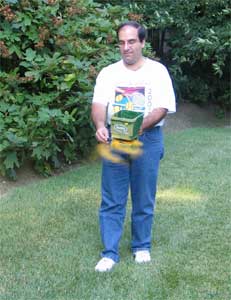Let’s face it, we love our lawns. Those green expanses are where we play ball with our kids, frolic with the pets and host our weekend barbecue.
Unfortunately, many of the synthetic chemicals we add to keep our lawns lush are not good for our families, or the environment. Many chemical weed and feeds contain herbicides that have been linked to increased rates of cancer in people and pets. The use of chemical fertilizers and herbicides by residential homeowners, including many of us in Fairfax County, is one cause of deteriorating water quality in the Chesapeake Bay.
 What can we do to keep our lawns, our families and the Bay healthy? The answer may be to use corn gluten! In the 1980’s Iowa State University turf grass researcher, Dr. Nick Christians, discovered the natural weed and feed capability of corn gluten meal, a protein-rich by-product of corn processing. Commonly sold as feed material for livestock and pets, corn gluten meal contains 10 percent slow-release nitrogen by weight, making it a natural fertilizer. In turf grass experiments with corn gluten, however, Christians observed a startling pattern. Turf plots where corn gluten had been applied seemed also to have fewer weeds! Corn gluten, Christians determined, contains amino acids that actually prevent seed germination, making it a natural pre-emergent herbicide.
What can we do to keep our lawns, our families and the Bay healthy? The answer may be to use corn gluten! In the 1980’s Iowa State University turf grass researcher, Dr. Nick Christians, discovered the natural weed and feed capability of corn gluten meal, a protein-rich by-product of corn processing. Commonly sold as feed material for livestock and pets, corn gluten meal contains 10 percent slow-release nitrogen by weight, making it a natural fertilizer. In turf grass experiments with corn gluten, however, Christians observed a startling pattern. Turf plots where corn gluten had been applied seemed also to have fewer weeds! Corn gluten, Christians determined, contains amino acids that actually prevent seed germination, making it a natural pre-emergent herbicide.
Corn gluten meal offers pre-emergent control of such weeds as dandelions, crabgrass, pigweed, plantain, lambs quarters and curly dock. Although it does not control perennial weeds like red clover or bentgrass that have already invaded your lawn, corn gluten’s nutrients do make your grass healthier and stronger. Over time, researchers have observed that these tough perennial weeds also become less prevalent as they are crowded out by a happy, healthy lawn. One distributor touts as much as 91 percent weed control after three years of twice yearly applications of corn gluten.
Corn gluten seems like a wonder product, but using it does have certain drawbacks. Compared to synthetic products, corn gluten meal is more expensive and offers less weed-control. And as with other pre-emergent herbicides, corn gluten must be applied close to the germination time of the target weed species, typically early spring. Despite our need to get out there with the daffodils and fertilize, this isn’t the best time to add nutrients to your lawn. Corn gluten is also non-selective; during the 4-6 weeks following application, it will prevent all seed germination. So if you use corn gluten, wait several weeks before overseeding your lawn. (Corn gluten can also be used for weed control around ornamental plants and vegetables, but be sure to keep the product out of beds in the 4-6 weeks before you sow seed.)
Despite these few drawbacks, corn gluten offers what most of us are looking for: a simple (and safe!) approach to lawn care. Horticulturists suggest applying 10-20 lbs. of corn gluten (the equivalent of 1-2 lbs. N) per 1,000 sq. ft. twice yearly, once in the spring, when daffodils and forsythia start to bloom (to prevent summer weeds from sprouting), and once in the fall, around Labor Day (for winter weed control and fertilization). The product directions suggest gently watering in the corn gluten to activate it. Still, it’s a good idea to check the forecast before each application. In general, applying lawn care products right before a rain won’t protect the Chesapeake Bay or your investment! During the month after application, water as little as possible to allow the soil to dry out periodically.
Corn gluten meal is sold as a yellow powder and in a granulated form appropriate for conventional spreaders. Both product types are available at many hardware stores and garden centers and are marketed under a variety of brand names including Cock-a-doodle DOO Organic Weed Control (Pure Barnyard Company, Inc.) and CONCERN Weed Prevention Plus (Woodstream Corp.). Don’t be afraid to ask for help from your garden center salesperson, or go armed with the list of currently licensed companies and product names from Nick Christians’ corn gluten web page at Iowa State (http://www.gluten.iastate.edu).
The Dirt about Fall Lawn Care
The advantage of weed and feeds including corn gluten meal is convenience. One product, one method of application, one trip to the garden center. However, when you apply corn gluten meal or any other weed and feed product, particularly in the spring, make sure not to over-fertilize your lawn. Cool-season grasses produce most of their roots from September to November making this the best time to fertilize. In contrast, spring fertilization stimulates blade growth (read: more mowing), but can weaken roots leaving your lawn susceptible to fungus and other disease-causing agents. Often too, in spring the grass just can’t use all the nutrients you’ve added and they wash away into our streams, ponds and Bay.
For the healthiest lawn (and Bay), have your soil tested every three years by the Virginia Tech Soil Testing Laboratory to determine your lawn’s fertilization and lime requirements. Soil sample boxes and forms are available at all Fairfax County public libraries or at the local Virginia Cooperative Extension office.
And if your lawn is in good shape, consider skipping your spring lawn rituals. It could help the Bay and will definitely save you time and money.

